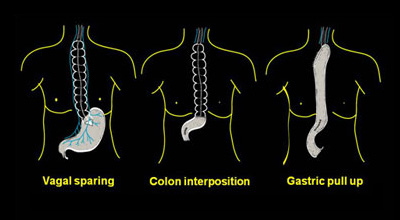Esophagectomy is a surgery that involves removal of the esophagus and replacement of the esophagus by the stomach, the colon (large intestine) or, in selected cases, the small bowel. When the stomach is used to replace the esophagus, the procedure is called “esophagectomy and gastric pull-up.”When the colon is used to replace the esophagus, the procedure is called “esophagectomy and colon interposition.” When the small bowel is used to replace the esophagus the procedure is called “esophagectomy and jejunal interposition.”
The procedure is performed for the treatment of:
- Malignant diseases of the esophagus: Esophageal cancer
- End-stage benign (non-cancerous) diseases of the esophagus:
- End-stage achalasia
- End-stage gastroesophageal reflux disease, Barrett’s esophagus with high-grade dysplasia, or in patients following multiple redo antireflux surgery.
- Intractable peptic ulcer (not responsive to medical treatment)
What Are the Types of Esophagectomy?
 Different types of esophagectomy are performed, based on the location and depth of the tumor (how deep the tumor has penetrated into the wall of the esophagus) if performed for esophageal cancer, and on the patient’s overall state of health and the surgeon’s preference.
Different types of esophagectomy are performed, based on the location and depth of the tumor (how deep the tumor has penetrated into the wall of the esophagus) if performed for esophageal cancer, and on the patient’s overall state of health and the surgeon’s preference.
Minimally Invasive Esophagectomy
This approach is performed by making small incisions in the abdomen and in the chest for removal of the esophagus. The stomach is most commonly used for esophageal replacement. To restore swallowing, the stomach is then connected to the remaining part of the esophagus in the chest or in the neck via a neck incision, a procedure called gastric pull-up. Studies have shown that this procedure can be performed with less morbidity and comparable oncologic results, compared to a standard esophagectomy.
Thoracoabdominal Esophagectomy
This technique is performed by making an incision in the left chest. The diaphragm is then opened and the incision is extended to the abdomen. The mid and the lower part of the esophagus are then removed. To restore swallowing, the stomach is then connected to the remaining upper part of the esophagus in the chest, a procedure called gastric pull-up.
Transhiatal Esophagectomy
Transhiatal esophagectomy is performed via an incision in the abdomen for removal of the esophagus. The stomach or the colon (large bowel) is then used to replace the esophagus. To restore swallowing, the small remaining upper part of the esophagus is then connected to the stomach (a gastric pull-up procedure) or the colon (a colon interposition) by making a second incision in the neck.
Transthoracic Esophagectomy
Transthoracic esophagectomy is performed by removing the esophagus through an incision in the right chest. A second incision is then made in the abdomen to use the stomach or the colon (large intestine) to replace the esophagus. To restore swallowing, the small remaining upper part of the esophagus is then connected to the stomach (a gastric pull-up procedure) or the colon (a colon interposition), either in the right chest or in the neck (by making a third incision in the neck).
En-bloc esophagectomy is a transthoracic esophagectomy which involves removal of the esophagus and all the tissues and lymph nodes around the esophagus via an incision in the right chest. A second incision is then made in the abdomen to use the stomach or the colon (large intestine) to replace the esophagus. To restore swallowing, the small remaining upper part of the esophagus is then connected to the stomach (a gastric pull-up procedure) or the colon (a colon interposition) in the neck, by making a third incision in the neck.
Vagal-Sparing Esophagectomy
Vagal-sparing esophagectomy removes the esophagus while preserving the vagal nerves. These nerves, called the vagal plexus, are located around the esophagus and, among other things, are responsible for the function of the stomach and the small bowel.
Following vagal-sparing esophagectomy, patients will have a better eating ability and fewer problems with symptoms, such as diarrhea, which may be present after other types of esophagectomy. In this procedure, an incision is made in the abdomen and the esophagus is removed but the vagus nerves are preserved. To restore swallowing, the stomach or the colon (large bowel) is then used to replace the esophagus and is connected to the small remaining part of the esophagus in the neck via a neck incision. If the stomach is used, to replace the esophagus the procedure is called a gastric pull-up. If the colon is used to replace the esophagus, the procedure is called colon interposition.
Recovery After Esophagectomy
Patients stay in the hospital for recovery 7 to 10 days, on average. They will be on a soft diet for about eight weeks following discharge from the hospital, and then gradually return to their regular eating habits.
Contact Us
If you have questions or are looking for more information, please complete the form below and we will contact you.